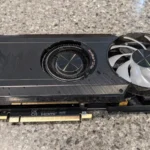How a computer accesses and uses its RAM and how much memory you have available to you is crucial to a system’s performance. Memory timings are one component that affects this performance. They measure the time a memory controller takes to receive data from the RAM. These timings are represented by a series of numbers — such as 4-4-4-8 or 9-9-9-24 — and each number reflects how many clock cycles are needed for a specific operation.
Memory speed isn’t just about the megahertz of the RAM but also about how quickly it can respond to requests from the CPU. The interplay between memory timings and frequency determines the actual latency, which ultimately impacts overall system speed. Tighter, lower timings can lead to better performance, allowing data to be accessed more rapidly and the system to run more smoothly.
Diving Deeper into RAM: Timings and Their Impact on Speed
What are Memory Timings?
Memory timings, often shown as a series of numbers (like 16-18-18-36), represent the time it takes for your RAM (Random Access Memory) to perform certain operations. Think of it as the coordination needed for a relay race; each number signifies a different step in the data transfer process. Lower timings generally mean faster operations, translating to better overall performance.
Key Memory Timing Metrics
| Timing | Abbreviation | Description |
|---|---|---|
| CAS Latency | CL | Time to access a column of data after the row is selected. |
| RAS to CAS Delay | tRCD | Time between activating a row and accessing a column. |
| Row Precharge Time | tRP | Time to close one row and open another. |
| RAS Active Time | tRAS | Time a row must remain active before it can be closed. |
How to Read Timings
A typical timing sequence looks like this: CL-tRCD-tRP-tRAS. Each number represents the number of clock cycles needed for that operation. Lower numbers are generally better, but all timings work together, so finding the right balance is key.
Why Timings Matter
While RAM speed (measured in MHz) gets most of the attention, timings play a crucial role in overall performance. Faster timings can lead to quicker data access, which benefits tasks like gaming, video editing, and content creation. It’s like having a well-coordinated team that can swiftly pass the baton, leading to a faster finish.
Balancing Speed and Timings
Choosing the right RAM involves balancing speed and timings. Sometimes, slightly looser timings with higher speed can outperform tighter timings with lower speed. It depends on your specific needs and the capabilities of your system.
Overclocking for Performance
Experienced users can try overclocking their RAM to improve timings and achieve even faster speeds. However, this requires careful tweaking and monitoring to avoid instability or damage to your hardware.
Key Takeaways
- Memory timings affect how fast a computer can access RAM.
- Lower numeric memory timings can improve system performance.
- The combination of memory frequency and timings determines the actual latency.
Fundamentals of Memory Timings
When building or upgrading a computer, memory timings are vital to understanding how quickly the system can operate.
Understanding Memory Specifications
Memory specs tell you about the speed and performance of RAM. For example, DDR4-3200 indicates a DDR4 type memory with a maximum transfer rate of 3200 MT/s (megatransfers per second). The DDR type has evolved over time from DDR to DDR5, with each new generation offering higher speed and performance.
RAM and the Memory Hierarchy
RAM sits near the top of the memory hierarchy due to its speed. It allows data to be accessed faster than from a storage drive but not as quickly as from the CPU cache. Fast RAM can keep up with the processor, avoiding bottlenecks and maintaining system speed.
The Role of the Memory Controller
The memory controller orchestrates access to RAM. It ensures data moves smoothly between the CPU and memory stick. The controller deals with aspects like the command rate and interacts with the RAM’s timing settings to manage performance.
Understanding CAS Latency
CAS Latency, short for Column Access Strobe latency, is a primary timing metric. It refers to the delay in clock cycles that it takes for the memory to deliver data requested by the system. For instance, CL16 on a 3200MHz memory module shows it takes 16 clock cycles to respond to a command. Lower CL means faster response time and better performance.







